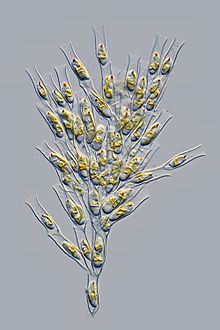Golden alga
| Golden algae | |
|---|---|
 |
|
| Dinobryon divergens, a tree like sessile form with cells in the cup-like shells | |
| Scientific classification | |
| Domain: | Eukaryota |
| (unranked): | SAR |
| Superphylum: | Heterokonta |
| Phylum: | Ochrophyta |
| Class: |
Chrysophyceae Pascher, 1914 |
| Orders | |
|
Chromulinales |
|
| Synonyms | |
|
|
Chromulinales
Chrysosphaerales
Hibberdiales
Hydrurales
Phaeothamniales
The Chrysophyceae, usually called chrysophytes, chrysomonads, golden-brown algae or golden algae are a large group of algae, found mostly in freshwater. Golden algae is also commonly used to refer to a single species, Prymnesium parvum, which causes fish kills.
The Chrysophyceae should not be confused with the Chrysophyta, which is a more ambiguous taxon. Although "chrysophytes" is the anglicization of "Chrysophyta", it generally refers to the Chrysophyceae.
Originally they were taken to include all such forms of the diatoms and multicellular brown algae, but since then they have been divided into several different groups (e.g., Haptophyceae,Synurophyceae) based on pigmentation and cell structure. Some heterotrophic flagellates as the bicosoecids and choanoflagellates were sometimes seen as related to golden algae too.
They are now usually restricted to a core group of closely related forms, distinguished primarily by the structure of the flagella in motile cells, also treated as an order Chromulinales. It is possible membership will be revised further as more species are studied in detail.
The "primary" cell of chrysophytes contains two specialized flagella. The active, "feathered" (with mastigonemes) flagellum is oriented toward the moving direction. The smooth passive flagellum, oriented toward the opposite direction, may be present only in rudimentary form in some species.
An important characteristic used to identify members of the class Chrysophyceae is the presence of a siliceous cyst that is formed endogenously. Called statospore, stomatocyst or statocyst, this structure is usually globose and contains a single pore. The surface of mature cysts may be ornamented with different structural elements and are useful to distinguish species.
...
Wikipedia
